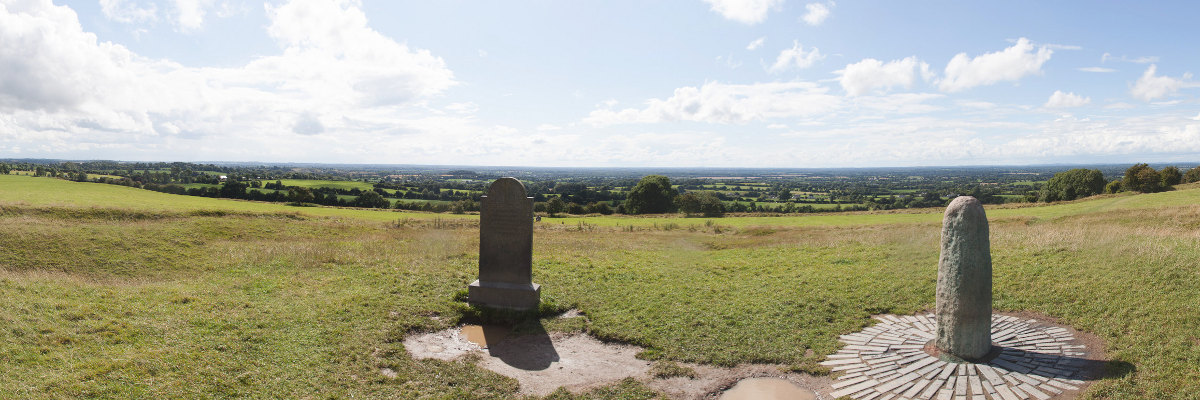Boyne Valley
Brú na Bóinne
Brú na Bóinne (Boyne Valley) is an area in County Meath, Ireland, located in a bend of the River Boyne. It contains one of the world's most important prehistoric landscapes dating from the Neolithic period, including the large Megalithic passage graves of Knowth, Newgrange and Dowth as well as some 90 additional monuments.
Since 1993 the site has been a World Heritage Site designated by UNESCO, known since 2013 as "Brú na Bóinne - Archaeological Ensemble of the Bend of the Boyne".

Image: The Hill of Tara
The area has been a centre of human settlement for at least 6,000 years, but the major structures date to around 5,000 years ago,
The site is a complex of Neolithic mounds, chamber tombs, standing stones, henges and other prehistoric enclosures, some from as early as 35th century BC - 32nd century BC. The site thus predates the Egyptian pyramids and was built with sophistication and a knowledge of science and astronomy, which is most evident in the passage grave of Newgrange. The site is often referred to as the "Bend of the Boyne" and this is often (incorrectly) taken to be a translation of Brú na Bóinne (Palace or Mansion of the Boyne). The associated archaeological culture is often called the "Boyne culture".
The site covers 780 ha (1,927 acres) and contains around 40 passage graves, as well as other prehistoric sites and later features. The majority of the monuments are concentrated on the north side of the river. The most well-known sites within Brú na Bóinne are the passage graves of Newgrange, Knowth and Dowth, all known for their collections of megalithic art. Each stands on a ridge within the river bend and two of the tombs, Knowth and Newgrange, appear to contain stones re-used from an earlier monument at the site. Newgrange is the central mound of the Boyne Valley passage grave cemetery, the circular cairn in which the cruciform burial chamber is sited having a diameter of over 100 metres. Knowth and Dowth are of comparable size. There is no in situ evidence for earlier activity at the site, save for the spotfinds of flint tools left by Mesolithic hunters.
The passage tombs were constructed beginning in around 3,300 BC and work stopped around 2,900 BC. The area continued to be used for habitation and ritual purposes until the early Bronze Age, during which a number of embanked, pit and wooden post circles (collectively referred to as "henges") were built. Artefacts from the later Bronze Age are comparatively inconspicuous: some cist and ring ditch burials and burnt mounds. For the Iron Age there is only evidence of sporadic activity, such as burials near Knowth and at Rosnaree. Valuable items from the Roman period such as coins and jewelry were found as votive offerings near Newgrange.
Each of the three main megalith sites have significant archaeoastronomical significance. Newgrange and Dowth have Winter solstice solar alignments, while Knowth is orientated towards the spring and autumn Equinox. In addition, the immediate environs of the main sites have been investigated for other possible alignments. The layout and design of the Brú na Bóinne complex across the valley has also been studied for astronomical significance.
Newgrange
Newgrange, which was built about 5,000 years ago, is Ireland's most famous prehistoric site.
It's especially famous for a spectacular event on December 21st, also known as the Winter Solstice, the shortest day of the year. The tomb was built in such a way that on this day, it is illuminated by a narrow beam of sunlight which shines through a specially designed roof box. Those who have seen this say its an unforgettable experience.
Nobody knows why the tomb was built in the way it was, or indeed how the stones were even transported to the site. But it does seem fairly certain that Newgrange was built before the invention of the wheel.
Hill of Tara
The Hill of Tara is also in Co. Meath. An archeological complex, it consists of a number of ancient monuments, including the Stone of Destiny, the Fort of the Kings and the Mound of the Hostages. Located on the River Boyne, it is said to be the actual seat of the High Kings of Ireland.
Nearby is the site of the Battle of The Boyne, one of the key dates in Irish history, in which protestant William of Orange defeated Catholic James II in 1690.
All access to Newgrange and Knowth is by guided tour only, with tours beginning at the Visitor Centre, opened in 1997 in Donore, County Meath. The tourist visitor centre is located on the south side of the river Boyne, and the historical site is located on the north side of the river and is accessed via a foot bridge with a tour guide.




















